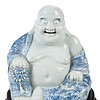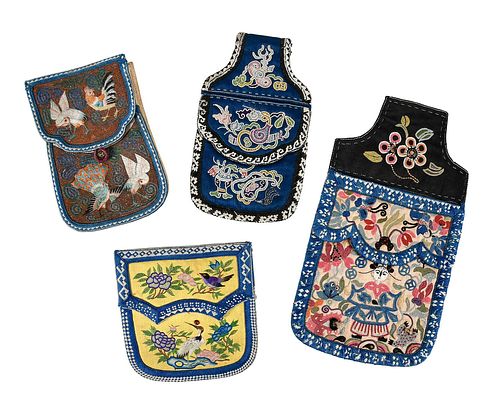Group of Four Chinese Embroidered Pouches
Bid Increments
| Price | Bid Increment |
|---|---|
| $0 | $25 |
| $100 | $50 |
| $1,000 | $100 |
| $2,000 | $200 |
| $3,000 | $250 |
| $5,000 | $500 |
| $10,000 | $1,000 |
| $20,000 | $2,000 |
| $50,000 | $5,000 |
| $100,000 | $10,000 |
late 19th/early 20th century, of varying size and form, with floral, bird, and figural decoration, two with forbidden stitch detailing, largest 8-1/4 x 4-1/2 in.
Note: Rooted in part in Asian history, the sachet appeared in the Warring States period as distinctive decorations worn as a clothing accessory as well as mosquito repellent. The origins of the ?fragrant sachet? has been assigned to rural Chinese women during the Han dynasty. During this time, an account appeared in the Book of Rites, compiled by Dai Sheng, which described the popularity of perfumed and embroidered brocade sachets, especially among young people who wore these sachets around their wrists, necks, and waists. They were also popular in the Tang (618-906) and Song (960-1279) dynasties, but were mainly luxuries for the wealthy and powerful. Qingyang?s male officials and women from elite families wore sachets filled with traditional Chinese medicine rather than perfume. Sachets would later be used as tokens of love and affection in the Qing dynasty (1644-1661). (wiki).
Provenance: From an extensive collection of textiles, dating from the mid 19th century to late Qing dynasty, Private Collection, ColoradoCondition
scattered light staining, a few pulled threads
Purchased items will be available for pick up or shipping from our Asheville, North Carolina auction facility within ten business days of the auction will be assessed a storage fee of $5.00 per day, per item. Purchaser agrees that packing and shipping is done at the purchaser's risk and that the purchaser will pay in advance all packing expenses, materials, carrier fees and insurance charges. At our discretion, items will either be packed by an agent such as a packaging store or Brunk Auctions. Please allow two weeks for shipping after payment is received. Shipment of large items is the responsibility of the purchaser. We are happy to provide names of carriers and shippers if a purchaser so requests. Brunk Auctions will have no liability for any loss or damage to shipped items.












